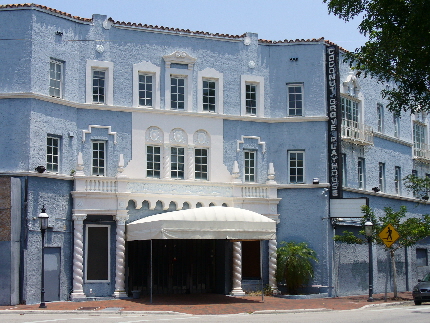 By Bill Hirschman
By Bill Hirschman
Fourteen years after the Coconut Grove Playhouse shuttered and almost exactly one year after another round of court proceedings began, opposing attorneys from Miami-Dade County and the City of Miami argued complex details of their dispute Tuesday before appellate judges.
The three-member panel did not issue a ruling immediately in what could be one of the last hurdles in the controversial battle over how the landmark theater would be renovated and reopened. But partisans on both sides have had that expectation more than once after earlier meetings, hearings and votes.
The county has asked the court to quash the City of Miami mayor’s veto of his city commission’s approval of the county’s application to rehabilitate the playhouse.
Attorneys for each side had 15 minutes to put forth their arguments in a Zoom cyber hearing before the 11th Judicial Circuit panel, but much of their time was taken up by judges asking questions about previously-filed briefs.
Much of the discussions centered on whether the county had the right to challenge the mayor’s decision, whether the interior of the building was legitimately considered protected on historical or architectural merit, and whether the county’s allegation that a city preservation board’s vice-chair had tainted a key decision by allegedly being biased against the county proposal.
The nationally-known Playhouse has been closed since 2006 – its 50th anniversary season — when an estimated $4 million in debts caused its non-profit board to shutter operations. But arts and county officials led by Mayor Carlos Gimenez and Michael Spring, director of the county Department of Cultural Affairs, had been striving for years before that to preserve some kind of theater operation on the site, and they are the prime movers behind the current effort.
Court arguments aside, at war are two visions. One group, primarily Grove residents and business owners, want the entire structure to be resurrected intact, in part for architectural preservation reasons. One of its champion’s proposal suggests a 700-seat theater could house a nationally-recognized theater akin to the Steppenwolf in Chicago, part of the region’s rise as an international cultural hub.
But the county contends that the 1926 former movie house at 3500 Main Highway is too badly damaged to reclaim, logistically as well as fiscally. Instead, it wants to restore the current façade to its former glory, build a park-like space behind it, demolish the rest of the structure and then build a new facility housing a 300-seat theater and classroom space. It would be used and managed by GableStage as a resident professional theater and by Florida International University for arts-related classes. Their partisans say a 700-seat theater could never be financially self-sustaining even with grants and donors.
The county’s $23.6 million plan would be financed mostly with earmarked bond issues proceeds already approved by voters. The other plan has been estimated to cost about $46 million with supporters saying that the balance could be raised from grants and donors.
A key element in court filings and public hearings has been whether a city preservation board previously did or did not endorse a county plan that would demolish the bulk of the existing building.
While either side could conceivably appeal a decision, the county has been anxious to advance the project as soon as possible. The county and FIU have a lease with the state Department of Environmental Protection, which actually owns the property.
Miami-based Arquitectonica has completed the bid package of architectural and engineering drawings, said Spring. Once the project has the go ahead, the drawings/specifications package will be submitted to the City of Miami Building Department for review for a construction permit. “We may simultaneously issue the drawings and specifications set for construction bids,” Spring wrote.
The tumultuous journey, often marked by hearings and meetings populated with passionate speakers, came to court this week after a drama more complicated than a Tom Stoppard play.
This third act climax began in 2017 when the county needed approval to begin significant work on the project. The edifice had been declared a historic site by the city in 2005, so the county had to apply for a “certificate of appropriateness” to the city’s Historic and Environmental Preservation Board known as HEPB. The board granted permission for a master plan in April 2017, which the county contends included demolition of some parts of the structure.
Two citizens appealed that decision to the Miami city commission, which granted a go-ahead with several restrictions that the county contended had nothing to do with historic preservation. The county appealed the city commission’s decision to the circuit court, which ruled in the county’s favor.
The county then proceeded with designing the project based on its understanding of the preservation board’s original ruling. When the county returned to HEPB for a final blessing, the board rejected the project.
In that dispute, the county and HEPB board disagreed in a complex debate on the whys, wherefores, definitions, architectural merits, what parts of the building are historically relevant – even the very legitimacy of the rejection. Much of it is centered on the county’s plan to demolish much of the aging deteriorating interior.
County officials appealed the HEPB board’s rejection to the Miami city commission. It sided with the county in a 3-2 vote following a heated and marathon public hearing. But Miami Mayor Francis Suarez vetoed that action. The commission then failed to override the veto in May 2019. That prompted the current appeal to the court.
The three-story edifice was designed as a silent movie house in 1926 in the Spanish Baroque “Mediterranean Revival” style by Kiehnel and Elliott Architects, and reworked slightly when a hurricane damaged it soon after. Unlike many movie palaces of the era such as the Fox Theater in Atlanta, the interior was not unusually ornate.
The application for preservation status called it “a noteworthy expression of the Florida Land Boom” whose “original design by the critically important architectural firm of Kiehnel and Elliott…. embodies the metaphoric Boom and Bust cycles that Florida has experienced, and continue as a signature building reflecting the heyday of Coconut Grove.” But county officials documented that it had been extensively altered inside and out since then, including creating a more lush interior.
After significant renovations, the structure became home to professional theater productions in the mid-1950s including the American premiere of Samuel Beckett’s Waiting For Godot.
About 35 viewers watched the 33-minute hearing before Judges Angelica D. Zayas, Daryl Trawick and Lisa Walsh.







 A PaperStreet Web Design
A PaperStreet Web Design
